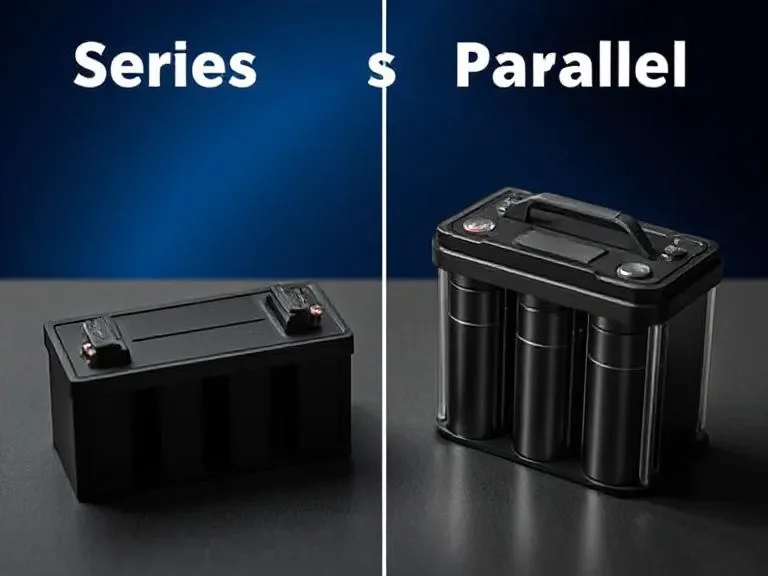Batteries in Series vs. Parallel: Which Is Better?
In this blog, we outline the core differences and use cases for wiring batteries in series versus parallel—helping you understand how to trade off voltage and capacity for your application.

1. What Happens When Batteries Are Wired in Series?
- Series Wiring: Adds each cell’s voltage while keeping capacity (Ah) the same.
Example: 4 × 3.7 V cells → 14.8 V total, still 3 Ah.
- Common Uses: E-bikes (36 V, 48 V packs), inverter inputs, high-voltage power-tool platforms.
Advantages of Series Wiring:
- Higher Voltage Output: Easily reaches the voltage requirements of high-voltage equipment without stepping up via DC-DC converters.
- Lower Current for Same Power: At a given power draw, current per string is reduced, helping minimize I²R losses and heat.
- Simplified Pack Size: Fewer parallel strings reduce overall pack complexity when only voltage increase is needed.
Disadvantages of Series Wiring:
- Cell Balancing Required: Each cell must stay within tight voltage windows, necessitating a BMS or balance board.
- Single-Cell Failure Risk: If one cell drops out or degrades, the entire string’s output collapses.
- Uniform Aging Needed: Mismatched capacities or ages accelerate imbalance and can shorten overall pack life.

WOR-20V-LI Lithium-Ion Battery For Worx RW/WG/WU/WX Power Tools
2. What Happens When Batteries Are Wired in Parallel?
- Parallel Wiring: Sums each cell’s capacity (Ah) while keeping voltage the same.
Example: 4 × 3 Ah cells → 12 Ah total, still 3.7 V.
- Common Uses: Solar home backup banks (12 V, 24 V), portable power stations, multi-flash camera rigs.
Advantages of Parallel Wiring:
- Increased Capacity / Runtime: Directly multiplies Ah for longer runtime without boosting voltage.
- Redundancy: A single weak cell draws less impact on overall pack performance if properly fused or monitored.
- Simpler Charging: Standard charger at nominal voltage suffices—no need for complex balance charging.
Disadvantages of Parallel Wiring:
- Higher Current Draw: To deliver equivalent power at the same voltage, currents in the bus rise, increasing wiring thickness and potential heat.
- Uneven Cell Sharing: Without equal wiring lengths and cell-level monitoring, some cells may over-discharge or over-charge first.
- Limited Voltage Scalability: Cannot meet higher-voltage requirements without adding series strings on top of the parallel bank.
3. Series vs. Parallel: Side‑by‑Side Comparison
| Metric | Series | Parallel |
| Total Voltage | Cell voltage × number of cells | Equals single-cell voltage |
| Total Capacity (Ah) | Equals single-cell capacity | Cell capacity × number of cells |
| Use Case | High-voltage equipment | Extended runtime applications |
| Balancing Requirement | Mandatory cell‑balancing circuitry | Cell-level fusing/monitoring advisable |
| Charger Needs | Multi‑cell balance charger | Standard charger at nominal voltage |
4. Practical Applications: Series vs. Parallel
- Series Applications:
E‑bike drive packs (36 V, 48 V)
High‑voltage LED arrays
Off‑grid inverter inputs
- Parallel Applications:
Solar battery banks (12 V, 24 V)
Portable power stations (e.g., camping)
Multi‑flash camera rigs

5. How to Wire Batteries in Series Safely
Materials Required
- Batteries: All batteries should match in type, voltage, and capacity.
- Connecting Cables: Choose wires rated for the expected current to prevent overheating or excessive voltage drop.
Procedure
1. Examine the Batteries
Verify that each battery is identical in type, voltage, and capacity to avoid imbalance and potential hazards.
2. Locate Terminals
Identify the positive (+) and negative (–) posts on every battery before making any connections.
3. Series Connection
Join the positive terminal of the first battery to the negative terminal of the next one. Continue this pattern through the entire string of batteries.
4. Secure the Wiring
Fasten the cables firmly and insulate all exposed connections to eliminate the risk of shorts or accidental disconnection.
5. Confirm Configuration
Recheck that the batteries are linked in series—forming a continuous chain from the first battery’s positive pole to the last battery’s negative pole.
6. Measure Voltage
Use a multimeter to confirm the total voltage corresponds to the sum of each battery’s voltage. Ensure the circuit is stable and all contacts are solid.
7. Follow Safety Protocols
Handle batteries with care: avoid short circuits, wear appropriate protective gear, and follow standard electrical safety guidelines throughout the process.
6. How to Wire Batteries in Parallel Safely
Required Materials
- Batteries: All units must match in type, voltage, and capacity to ensure consistent performance.
- Connection Cables: Select wires rated for the anticipated current to avoid overheating or voltage drop.
Step‑by‑Step Guide
1. Check Battery Uniformity
Confirm every battery slated for parallel connection shares the same chemistry, voltage, and capacity. Disparities can cause uneven charging and lower overall efficiency.
2. Mark Terminals
Locate the positive (+) and negative (–) posts on each battery and clearly distinguish them before proceeding.
3. Link All Positives
Using suitable cables, tie together the positive terminals of all batteries to form a single positive bus.
4. Link All Negatives
In the same way, join the negative terminals with separate cables to create a unified negative bus.
5. Tighten and Insulate
Ensure every connection is snug and properly insulated. Use connectors and insulation rated for your system’s current to prevent shorts or accidental disconnections.
6. Confirm Parallel Layout
Verify that all positives are united and all negatives are united. In parallel wiring, each terminal group remains independently linked rather than chained.
7. Evaluate Combined Capacity
Before putting the bank into service, measure the total capacity (e.g., with a battery analyzer) to make sure it matches your calculated expectations.
8. Maintain Safe Practices
Always work with protective gear, avoid bridging positive and negative terminals inadvertently, and follow established electrical safety guidelines throughout.

7. FAQ: Series vs. Parallel Essentials
1. Which Is Better: Series or Parallel?
Series for higher voltage; parallel for longer runtime. Many systems use a combination (series‑parallel) for both benefits.
2. Can I Mix Different Batteries?
Never mix cells of different capacity, age, or chemistry—it causes imbalance, shortened life, and safety risks.
3. Do Batteries Last Longer in Series or Parallel?
Parallel arrangements often age more gracefully; series strings demand strict balancing to avoid early failure.
4. What If One Battery Fails?
- Series: Entire string loses output.
- Parallel: If fused/monitored, a bad cell can be isolated; otherwise it may over-discharge the rest.
8. Key Takeaways & Next Steps
- Series vs. Parallel: Series increases voltage, parallel increases capacity; combining both topologies gives you the best of both worlds.
- Safety Reminder: Always use matched cells, correct wiring, and a suitable BMS or protection scheme.
- Next Steps: Determine your system’s voltage and runtime requirements, then choose—and wire—the appropriate configuration with proper balancing.
Conclusion
Implement these guidelines to build safe, reliable battery packs that exactly fit your voltage and capacity needs!